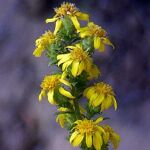| Common Name: |
Goldenrod |
| Botanical Name: |
Solidago vigaurea |
| Genus: |
Solidago |
| Family: |
Asteraceae |
| Native Location: |
Europe. |
| Cultivation: |
Well-drained, sandy to poor soil in sun. Leaves may be damaged by powdery mildew. The flowers of Solidago attract many different beneficial insects, such as lacewings and ladybugs, which are effective in controlling pests, especially aphids. |
| Propagation: |
By seed sown in spring; by division in autumn or spring. |
| Harvest: |
Leaves and flowering tops are picked before flowers are fully opened and dried for use in infusions, liquid extracts, ointments, powders, and tinctures. |
| Height: |
80cm (32in) |
| Width: |
45-60cm (18-24in) |
| Variations: |
Subsp. minuta
Is dwarf. Needs moist soil.
Height: 20cm (8in)
Width: 20cm (8in) |
|
| Hardiness: |
Z3-9 |
| Parts Used: |
Leaves, flowering tops. |
| Properties: |
A bitter, astringent, relaxant herb that reduces inflammation, stimulates the liver and kidneys, and is also a good urinary antiseptic. It is also expectorant, improved digestion, promotes healing, and has anti-fungal effects. |
| Medicinal Uses: |
Internally for kidney and bladder stones, urinary infections, chronic mucus and skin diseases, influenza, whooping cough, flatulent dyspepsia associated with nervous tension, gastric infections in children, and fungal infections (such as Candida). Externally for wounds, insect bites, ulcers, sore throat, vaginal and oral yeast. Combines well with Gnaphalium uliginosum (See, Marsh Cudweed) for nasal mucus. |
| Bibliography: |
Encyclopedia of Herbs by Deni Brown Copyright © 1995, 2001 Dorling Kindersley Limited. pp 371-372 |
